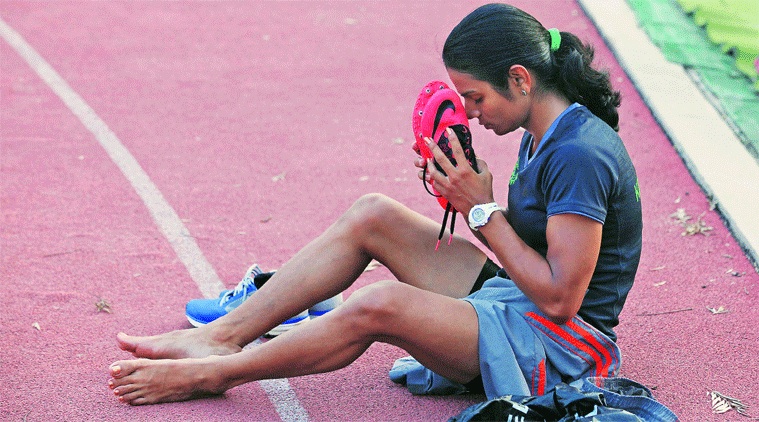20 October 2014
Since 1928 international athletics has included separate categories for men and women. This separation makes sense to most people on a lot of levels. In terms of social equity, it is appropriate that women have the same chance as men to compete at the highest levels of athletic competition, even though full equality is not always realized in practice.
In terms of biology, women are in general smaller and weaker than men, so having a mixed competition would lead to virtually no women competing in athletics. Most of the time, separating women and men in athletic competition works well. But when questions arise about who is and who is not eligible to participate in women’s events, things get messy. And as the popular legal maxim has it, hard cases make for bad law.
The latest controversy over participation in women’s athletics involves an Indian sprinter, Dutee Chand. She has run afoul of policies recently implemented by the International Association of Athletics Federations (IAAF) for determining eligibility to participate in women’s athletics. The IAAF oversees track and field competitions under the Olympic movement. Despite IAAF protests to the contrary, these policies are the most recent incarnation of “sex testing,” used to classify individuals as male or female for purposes of competition.
Chand has what doctors call hyperandrogenism, which means that her body naturally produces an excess of androgens, such as testosterone. About five to 10 per cent of women of reproductive age are estimated to have an androgen excess.
The IAAF determined in 2011, prior to the London Olympics, that it would use an athlete’s androgens, focused on her level of testosterone, as the primary factor for determining eligibility for participating in women’s athletics events. It implemented this policy after its poor handling of the case of Caster Semenya, a South African sprinter who fell victim to the IAAF’s lack of clear policy for participation in women’ events. She suffered degrading treatment by athletics officials and in the media, before the IAAF finally ruled her eligible to compete.
The IAAF put forward its androgen (testosterone) policy apparently in hope of establishing an unambiguous, scientific standard for determining eligibility to participate in women’s athletics events. In many areas of decision making we would love for science to offer us bright lines to separate one side from another.
The use of biological characteristics to differentiate among athletes is widely practiced and accepted. My city recreation department includes a basketball league for those 6 foot and under and also a soccer league for players who are over 40 years old. Elite athletes now can compete in “masters” events broken down by age. Olympic weightlifters and wrestlers are organized by body weight. Professional cyclists have upper limits on their hematocrit levels.
However, biological sex does not fall neatly into two unambiguous categories, but along a spectrum characterized by shades of grey. The World Health Organization explains, “there is a range of chromosome complements, hormone balances, and phenotypic variations that determine sex.” As David Epstein writes in The Sports Gene, “neither body parts nor the chromosomes within them unequivocally differentiate male from female athletes.” Science cannot draw a bright line between male and female, because there is no such line.
The IAAF androgen policy would be perfectly acceptable if there was a general consensus on naturally occurring testosterone as a relevant physical characteristic to separate athletes into different competition classes. After all, the logic behind separating out athletes by age, weight and blood oxygen levels is fairly obvious. But there is no such consensus on testosterone.
Ben Koh, chief medical officer at the Commonwealth Bank of Australia, and colleagues observe that a recent study, “found a complete overlap between the testosterone levels in elite men and women, with 16.5% of men with a low testosterone value and 13.7% of women with a high one. “ Imagine if in Rio 2016 the Olympics decided to do away with men’s and women’s events and instead announce the Low-T and High-T categories of competition. It would not go over very well.
The IAAF has created a policy that risks giving the impression, at least, of hiding behind science a preference for certain social norms for what constitutes femininity in a woman’s appearance as criteria for participation. The current IAAF policy encourages women to undergo medical treatments or procedures to make them more female typical, if they are to be eligible to compete. More fundamentally and less charitably, the IAAF policy implies that women, through their lack of testosterone, are to be viewed as “deficient men.”
The IAAF argues that some women with hyperandrogenism may have some natural-born athletic advantages over other women. While this point is contested, even if it were true, it should not matter. Athletics is a celebration of humans who are born with rare physical characteristics.
For instance, many women basketball players have grown to a physical height that is rare even for the tallest men. In The Sports Gene, Epstein recounts the career of Eero Mäntyranta, a champion Finnish cross country skier who had a condition called polycythemia, which led to levels of red blood cells 65% higher than the average person. Long suspected of doping, when Mäntyranta’s condition was identified, he was not ostracized from sport, but fulsomely accepted. His condition was natural, not the product of doping, what a relief!
If sport were to prohibit the participation of individuals with rare or extreme biological characteristics, it would be the end of elite sport. Anyone wanting to see ordinary humans compete just need go down to their local gym or pitch on a Sunday afternoon.
Unless sport is to do away with the distinction of men’s and women’s events in athletics, it will need to develop criteria for participation in women’s events that reflect the socially constructed nature of those categories. The alternative is continuing controversies over participation in women’s events because women like Chand and Semenya will occasionally be unfairly prohibited from participating because of a rule that clearly violates common sense notions of the spirit of sport.
The fundamental problem here is that the IAAF is still trying to use a rigid view of biological sex as binary as a proxy for identifying the gender of athletes, which is anything but binary. Gender, according to the WHO, is “typically described in terms of masculinity and femininity, is a social construction that varies across different cultures and over time.”
Science has developed a rich understanding of biological sex traits and their complexities. As a social construction gender is also characterized by shades of gray which do not correspond neatly to the complexities which characterize biological sex. The IAAF is thus trying to use science as an arbiter of a social construction. Such an approach is certainly doomed to fail. Hard cases make for bad law.
Consequently, the IAAF policy focused on testosterone does not distinguish men from women in terms of the common sense categories found across society. Instead, the policy distinguishes people according to testosterone levels naturally occurring in their bodies. Consider that the IAAF policy currently allows participation in women’s events by those who – in the language of the WHO – are “genetically male” with XY chromosomes and are androgen insensitive, but who are female by gender. In plain English and common sense, they are women with XY chromosomes.
An important first step in improving the IAAF gender verification policy is to recognize first and foremost that it is focused on a social construction, not a biological fact. As scholars have learned in many settings, science is ill-suited to resolve difficult questions involving values and norms.
Some experts, such as Stanford University’s Katrina Karkazis and Northwestern’s Alice Dreger, who have studied policies for gender testing in athletics, have recommended that the IAAF just do away with most criteria altogether, and allow anyone to participate in women’s events whose national legal status says that they are a woman. However, not all nations have such a legal designation, and some countries have been known to game policies for athletics, such as with legal nationalities.
Bruce Kidd, a former Olympian and current academic, says to just do away with criteria altogether. This approach has many merits, not least of which is the dignity of the individual, but it could also open the door for mischief, not necessarily men posing as women, but gamesmanship by those opposed to such a policy.
A slightly more formalized version of this approach, however, might be possible. Anyone who has spent their life living as a woman, whether in South Africa or India or elsewhere, should automatically be eligible for participation in women’s events. Full stop. The IAAF (as does the National Collegiate Athletics Administration in the US) has policies in place governing eligibility of those who undergo sexual reassignment from male to female (as determined in the context of the laws of various nations). Those policies would not be affected by doing away with the IAAF androgen/testosterone policy.
A simple affidavit signed by the athlete stating that she has lived her life as a woman, and not as a man, should suffice. Anyone found to have falsified such information, which no doubt would be rare, would then face disqualification. The IAAF would no long use drug testing, biological passports, medical inspections or other means to determine an athlete’s qualification for participation in women’s events. The onus of responsibility for representing an athlete as a woman would lie with the athlete, not sporting bodies.
Dutee Chand has appealed her case to the Court of Arbitration for Sport, in Lausanne, Switzerland. Both science and the spirit of sport help to show that the current IAAF policy for gender verification is deeply flawed. The case offers an opportunity for the sporting community to finally get this issue right. Or it could compound the errors of the past. Let’s hope it chooses wisely.
.
Roger Pielke Jr. is a professor of environmental studies at the University of Colorado, where he also directs its Center for Science and technology Policy Research. He studies, teaches and writes about science, innovation, politics and sports. He has written for The New York Times, The Guardian, FiveThirtyEight, and The Wall Street Journal among many other places. He is thrilled to join Sportingintelligence as a regular contributor. Follow Roger on Twitter: @RogerPielkeJR and on his blog
.











